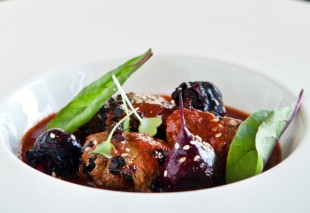

Cuisine Focus 2014: Indian

Indian food can be found everywhere in the Middle East, and the love affair with the various spices and cooking methods continues to enthrall consumers, as Jamie Knights discovers
Meet the Experts
- Siddharth Krishna, head chef, Spice Mela, and executive sous chef, Rosewood Abu Dhabi
- Akshay Nayyar, corporate chef, Sanjeev Kapoor Restaurants
- Nandan Singh, chef, Biryani Pot
- Froz Khan, chef, Claypot, Citymax Hotels Bur Dubai
- Jurgen Lepping, executive chef, Radisson Blu Hotel Doha
How popular is Indian food in the region?
Nandan Singh, chef, Biryani Pot: Indian food and the spices we use in our cooking are very popular in the UAE and wider Middle East. The reason for this is not only because of the large Indian population in the region, but also because of the popularity of Indian food with people of Middle Eastern origin. India has been a trading partner of the Middle East for a long time, and as such, people in this region are very familiar with what Indian food has to offer and have grown to love the cuisine.
Siddharth Krishna, head chef, Spice Mela, and executive sous chef, Rosewood Abu Dhabi: Indian food is very popular in the Middle East. This is primarily due to the fact that historically this region and India have always been connected through trade.
Froz Khan, chef, Claypot, Citymax Hotels Bur Dubai: Indian food evolved through time due to Middle Eastern influences, as traders kept travelling to India to settle down. In recent times, the Indian workforce has settled in the Middle East in huge numbers. Because of this, modern Indian cuisine has become very popular among the local population, and has evolved simultaneously.
Akshay Nayyar, corporate chef, Sanjeev Kapoor Restaurants: Indian cuisine has found its right place in this part of the world. Whether street food or exclusive fine dining, UAE excels in it. This is primarily due to the popularity of the cuisine for its distinguished flavours.
Jurgen Lepping, executive chef, Radisson Blu Hotel Doha: Indian food is very popular in this part of the world not only because there are a large number of Indian people living here but also because many Europeans are big fans of the cuisine. The British, in particular, choose Indian food because they like to experiment with new dishes and flavours. They have even created their own Indian-inspired dish chicken makhanwalla, which is not Indian by origin but can still be found on menus in almost every Indian restaurant.
Is it hard to source ingredients?
Krishna: The products are fairly easily to obtain as this region has a great supply chain for importing food items. For example, the spices I use come directly from India.
Lepping: Getting supplies to cook Indian food is not at all difficult due to the fact that India is so very close to the Middle East. In addition, spices and Indian vegetables are widely available in supermarkets and vegetable markets here.
Nayyar: I have never faced a challenge — I have been able to get a few ingredients which are hard to find even in India.
Khan: Supply streams for Indian food ingredients are quite organised. To cater to various segments, high to low quality ingredients are available. Traders from Indian sub-continent like India, Pakistan, Sri Lanka and Bangladesh are well established in the business and always ready to explore opportunities.
Singh: Dubai has always been and remains a global trading hub, and therefore availability of produce is not an issue that we need to contend with as chefs preparing Indian cuisine in the UAE or wider region.
What are some of the challenges you face?
Krishna: There aren’t any major challenges I’ve come across during my time here. The client profile is similar to London, where I worked previously: well-travelled and knowledgeable guests.
Singh: The Middle East, and in particular the UAE, is a very diverse place with many different cultures and nationalities. Our biggest challenge is satisfying the differing tastes and spice requirements of guests, whilst trying to maintain uniformity in our product offering.
Khan: Meeting expectations of various taste buds. Indians like hot and spicy curries, whereas Arabs and expats prefer medium or non-hot spices. It’s a challenge and chefs need to know exactly who are they cooking for.
Lepping: Running an Indian restaurant is not too difficult here and the challenges with this type of cuisine are generally quite low. The only challenge we do face is sourcing good Indian chefs as they are always in very high demand.
Nayyar: Competition is very high when it comes to Indian food, but taste and quality is something that sets you apart from your peers. Perception of people naming Indian food as an extremely spicy cuisine has changed, but there is still some scope for people to try it more often.
Any emerging trends in Indian cuisine you can share?
Khan: It’s evolving daily. Diners prefer lighter food; grills and tawa are becoming popular; combo Indian lunch like salads, kebabs and breads; home-style tiffin; and some new restaurants and innovative chefs are using technological advancements to present their food, like molecular gastronomy, liquid nitrogen and various props with the food.
Nayyar: New creations is the trend, however authentic flavours are the roots. Healthier options, and moderate spicing are a few others I can name.
Krishna: Indian cuisine is continuously evolving. Today, chefs who cook Indian dishes try to make them lighter and incorporate modern cooking techniques.
Singh: Experimental cooking or molecular gastronomy, as it is often called, is a growing trend among master chefs and is starting to make an impact on Indian cuisine as well. Examples of this would be curry flavoured ice cream or dishes where different flavours are perceived in a certain sequence. Although it will probably be a while until this form of cooking and food preparation becomes mainstream, we are certainly seeing the impact of this trend.